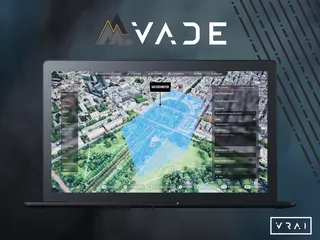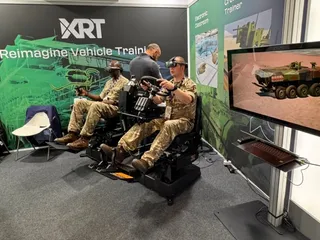CAT interview: CAE’s Nick Leontidis
Contact Our Team
For more information about how Halldale can add value to your marketing and promotional campaigns or to discuss event exhibitor and sponsorship opportunities, contact our team to find out more
The Americas -
holly.foster@halldale.com
Rest of World -
jeremy@halldale.com

In his first interview since becoming CAE Group President, Civil Simulation Products, Training and Services, Nick Leontidis speaks with Rick Adams.
In June, longtime CAE business development leader Nick Leontidis took over the reins of CAE’s civil aviation simulation and training businesses, succeeding Jeff Roberts, who spearheaded the unit for more than a decade.
Although he has been largely invisible on the public stage, Leontidis has been a strategic player in CAE’s transformation from a simulator manufacturer into a holistic training services company. Several years ago, he was in the middle of CAE’s acquisition of Sabena Flight Academy (Belgium and the US) and Nationale Luchtvaartschool (NLS) ab initio campuses in The Netherlands and Portugal, the germination of the CAE Global Academy network (now CAE Oxford Aviation Academy).
On the commercial scene, Leontidis helped engineer joint ventures with China Southern Airlines, Iberia, AirAsia, and others, a partnership foundation for what is now the world’s largest independent training network for commercial airline pilots – which will be 162 full flight simulators strong by March 2014.
Leontidis was also the point man in developing CAE’s new healthcare and mining industry businesses over the past five years.
[caption id="attachment_2370" align="alignleft" width="218"] CAE's new civil aviation leader, Nick Leontidis[/caption]
An engineering graduate of Concordia University, he spent a year at Bombardier Aerospace following his master’s degree programme, and has been at CAE for the past quarter-century.Leontidis reports directly to CAE President and Chief Executive Officer, Marc Parent.
Market Challenges?Montreal, Canada-based CAE has dominated the civil aviation full flight simulator (FFS) market for a number of years, annually winning market share of two-thirds to three-quarters of the 40-50 openly competed FFSs. They have also built the world’s largest network of commercial flight training centres, the largest cadet flight school group, and the second largest business aviation and civil helicopter simulator fleet.
In the past two years, however, the competitive landscape has changed significantly. Three major new players have entered or re-engaged with the commercial FFS market: Lockheed Martin acquired Sim Industries, L-3 absorbed the airline-oriented simulator operations of Thales, and Rockwell Collins – after a bit of dormancy following its assemblage five years ago of NLX, Evans & Sutherland, and SEOS – has announced aggressive plans for the training sector. The newly heated competition has, no doubt, shifted the advantage to airline buyers and driven simulator prices down, especially in the Asia-Pacific region where more than half of FFSs are now sold and where CAE not long ago enjoyed a 10-for-10 sales year (led by Leontidis in his China sales leader role).
“There's no doubt that they're being aggressive out there,” acknowledged Marc Parent, CAE President and CEO, at the company’s quarterly financial call with analysts in November. “Competition is certainly a factor. It's predetermined.”
Parent vowed, “We're going to protect our market share. We've been a leader in this market for a long time. That affords us some level of closeness with our customers … and so I believe this is not going to be, in the end, a price shootout down to the last cent everywhere. And that's not the kind of game we play.”
Over the past 18 months, CAE has also been integrating its acquisition of the Oxford Aviation Academy, which had been its largest competitor in the commercial and ab initio training domains. “I think we had a good handle on what we were doing on the integration of Oxford. I think what we … certainly underestimated is the amount of disruption that this causes. We moved a lot of things at the same time – tasking the same people in doing the same things and asking to do them in such a way that it's just hard to do at the same time. At the same time, we started moving other things because of the market softness, particularly in Europe and South America. So we kind of amplified the problem.
“But I'm really confident. We have a pretty good handle on what happened, where we are, and what needs to be done.”
Through mid-November, just 7.5 months into its fiscal year, CAE announced it had sold 33 FFSs year-to-date, with a record civil backlog just shy of Cdn $2 billion. “We are well on our way to reach our goal of a record 40 sales this fiscal year,” Parent stated. The most FFSs CAE (or anyone in the industry) has sold in a single year is 38.
‘The recipe is simple’CAT: CAE has evolved into a comprehensive training company, but the industry still tends to focus on the flagship technology, full flight simulator sales. How does CAE plan to maintain its lofty FFS market share against an increasing number of deep-pockets competitors?
Leontidis: The biggest driver for simulators, of course, is new aircraft deliveries. Aircraft deliveries are up, so the overall simulator number is bigger.
Simulator sales are a metric, but it’s not just about the simulator. We try to compete at a different level by offering solutions. Ab initio, Parc personnel leasing, type-rating training organisations. Many airlines in the emerging markets are growing rapidly and have a lot of needs; we have a number of services that make us more attractive.
It’s like buying a new car. You’ll favor the supplier you had as long as your experience with the product is to your satisfaction.
We’ve always had a strong sales incumbency, and we’ll continue to invest in technology and customer service. The recipe is very simple; it’s not complicated.
CAT: You are partnered with Chinese companies such as AVIC and COMAC on simulator development projects. Do you foresee the day when China will attempt to develop an indigenous flight simulator capability?
Leontidis: Maybe. I don’t really have a view on that. It’s not something I pay a lot of attention to. If they do, we can’t stop them.
Historically, we’ve been in that part of the world for 20, 25 years. We know the customer. We understand the need. We work hard to maintain those relationships. And we will continue to develop and invest in services. We don’t take short-term views.
CAT: Prior to implementation of the US Federal Aviation Administration’s (FAA) new rule on Part 121 commercial First Officer licensing, increasing the minimum number of flight hours from 250 to 1500, CAE and others had lobbied strenuously but unsuccessfully to allow flight simulator hours for up to half of the total. Are you continuing efforts to get the rule modified?
Leontidis: No, we’re just trying to develop products for what the rule is. We have taken a number of initiatives in our training business to address the rule, to accelerate the process for airlines, such as offering programs for pilots to reach the 1000-hour level allowed with an academic degree – either by ourselves or with universities.
CAT: In recent months, you have announced new Multi-crew Pilot Licence (MPL) programmes with Japan Airlines and Singapore-based Tigerair. It had been more than a year since CAE’s five-year, 200-cadet MPL deal with AirAsia. Why the relatively slow uptake of MPL programs when there’s such a large shortage of pilots forecast?
Leontidis: MPL is starting to gain some traction. Airlines in Southeast Asia and the Middle East are more progressively pushing it. In the US, it’s probably five years away. Airlines are not resisting. This is an important change, quite dramatic, and they want to see the evidence, rightfully so. In fact, a lot of airlines are keeping both options active [MPL and traditional Air Transport Pilot Licence - ATPL training]; they want to see the differences. It takes time, 12 to 18 months, to see how a pilot develops.
Our AirAsia program has graduated two classes, and they are all flying as line pilots. All indications are good about the quality of their skills, professionalism, and crew rapport. The results are very strong out of this programme.The third AirAsia class, and the first to be trained entirely in Malaysia, is just starting transition to the Intermediate phase in Kuala Lumpur; the next three AirAsia classes are in the Core and Basic phases.
CAT: Business aviation has not yet recovered to pre-recession levels, and the pace of simulator deployment in that segment has slowed considerably with only four bizjet simulators announced this year. How do you view that training market?
Leontidis: There continues to be some softness in the business aviation market, but there’s a large installed fleet, and we continue to invest in footprint for our platforms, especially big cabins. The large cabin category is a pretty robust market. We also focus, of course, on new airplanes, and there’s a lot of new product coming out.
CAT: CAE and competitors have been aggressively installing new helicopter flight simulators in the past year, particularly in South America, Europe, and Asia. What are the key reasons for that activity?
Leontidis: In terms of size, it’s still a relatively small market, but we’re seeing more investment in the adoption of six-degree-of-freedom simulators to train helicopter pilots. We’re both selling simulators and putting up training capacity for them. The light helicopter category adoption has not matured enough, but definitely the bigger helicopters have more sustained momentum. There are a number of capabilities that are quite major in making the simulator useful for training: landing on oil rigs, low altitude flying, and the use of night vision goggles.
CAT: How has your life changed with the new role?
Leontidis: It’s an exciting job in an exciting time. There are a lot of good market opportunities. I’ve spent a lot of my time getting immersed in the business, seeing the diversity, getting acquainted with the team and the customers across the businesses.
CAT: What do you like to do when you’re not traveling and working?
Leontidis: Get reacquainted with my kids.


